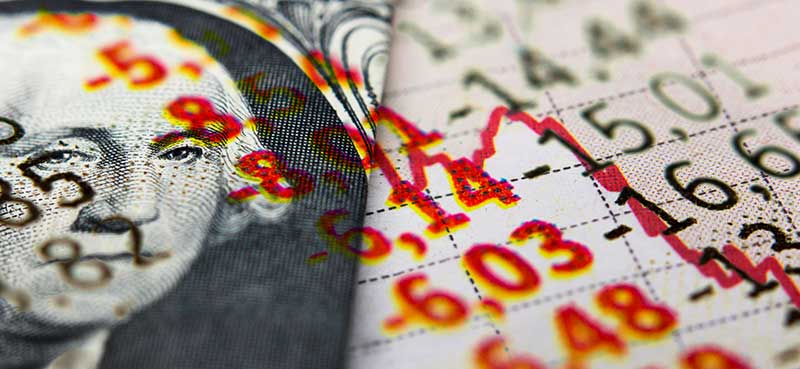Omicron—the newest COVID variant discovered in South Africa—has been spooking the market since it made its first appearance late last week.
Even yesterday’s 1.4% rally didn’t save the market from losing 2.7% in five days.
But Omicron isn’t the biggest problem facing the market…
I’ll explain what it is below… and one of the best ways to prepare for a worst-case scenario.
Omicron has already made its way to the U.S. But it’s important to remember it’s not 2020… Today, the medical community is on high alert—and has a much better understanding of COVID than it did a year and a half ago. Pharma companies are already studying the new variant in order to improve vaccine efficacy… And several antiviral therapies are now available to combat COVID (Merck and Pfizer even have COVID treatments in pill form).
Plus, new vaccines—specially formulated for Omicron—aren’t that far away… with leading mRNA companies expecting results in a few months.
And our existing vaccines seem to be working too.
That said, until we know more about the new variant, we’re facing a few weeks of uncertainty.
And the level of uncertainty surged dramatically on Tuesday.
With impeccable timing, Fed Chair Jerome Powell added to the selloff by admitting inflation isn’t conforming to his “transitional” scenario… and signaled the possibility of a faster taper.
This was when the market panicked.
You can see it on the chart below: stocks and even precious metals dropped sharply when the market realized Powell is about to throw in the towel… and start fighting inflation.

To put it simply, stocks revolted at the possibility that the proverbial punchbowl will be finally taken away.
The stock market loves the Fed’s easy money policies… And plenty of stocks had rallied to unsustainable highs on zero interest rates and massive Fed buying. Powell’s announcement gave traders a reason to take gains and regroup.
But the bond market wasn’t buying the faster taper talk…
Long-dated government bonds, represented on the chart below by the iShares 20-plus year government bond ETF (TLT), rallied 5% in just a week… to their highest level in 6 months.
As a result, long-term yields dropped sharply. (For bonds, price and yield always move in opposite directions.)

Meanwhile, shorter-dated bonds—such as the iShares 1-3 Year Treasury Bond ETF (SHY) on the chart above—barely moved.
A flatter yield curve leaves the Fed little room for actual rate hikes.
It also means trouble for one of the most important market sectors: banks… the leading positions in the Financial Sector SPDR ETF (XLF).
Even though the financial fallout from Omicron likely won’t look anything like the record-fast crash we saw in 2020… banks are set to lose if the yield curve continues to flatten… And that’s a likely outcome even if the Fed accelerates its taper… or if the Omicron variant proves more dangerous to the economy than the market currently anticipates.
Before beginning its pullback last Friday, the XLF had been rallying in anticipation of a stronger economy and faster rate hikes.
But the new COVID variant likely means continued low long-dated rates… the ones at which the banks usually lend.
Keep in mind, banks make their money on the difference between the rates at which they borrow and lend. Low interest rates make borrowing cheap… but also make it harder to charge more for loans. This will negatively impact banks’ profit growth… and make them less desirable investments.
Plus, the financial sector is highly leveraged to the economy. That means betting against it can be a great hedge against a deflationary event or a recession-related market decline.
In 2008, the XLF lost 56.7%—more than a half of its value—while the market declined by 38.3%.
Typically, bank stocks rally more than the market at the end of recessions… anticipating the higher rates that go hand in hand with a healthier economy.
This is what we’ve seen in 2021: financials are up about 9% more than the market this year (and have gained 14% more than the S&P from the market’s 2020 lows). Put simply, these stocks have lots of room to decline from here.
One way to benefit: via inverse ETFs.
These funds are designed to create a mirror image of the daily moves in a specific sector or index.
One rule of thumb to remember: the more leveraged the inverse ETF is, the more it will deviate from its stated target if you hold it for a long time.
This is why the best inverse ETF to hedge against the worst-case market scenario is the ProShares Short Financials ETF (SEF).
Designed to deliver the opposite of daily returns on the entire U.S. financial sector, SEF gained 4.3% in the 5 days of the market selloff … while the XLF lost 6.3%.
As always, be careful with inverse ETFs: their use of leverage makes them better suited for short-term trades than for long-term investments.
And in the case of SEF, which only has $9 million in market cap, limited liquidity can potentially impact your results as well.
But in an increasingly dangerous market, this ETF can help you hedge against a worst-case scenario involving either the new COVID variant… or the market revolt against future interest rate hikes by the Fed… either of which could slam the brakes on the financial sector.
Editor’s note:
Genia’s Unlimited Income advisory is one of the best services to follow in a rocky market. It’s a portfolio full of stocks chosen for safety, income, and growth in almost any market.
Members have been able to lock in quick capital gains as high as the triple digits… while earning market-beating dividends.
Join here for immediate access to the entire portfolio… and a free report on the top income stocks to buy—and avoid—TODAY.





















